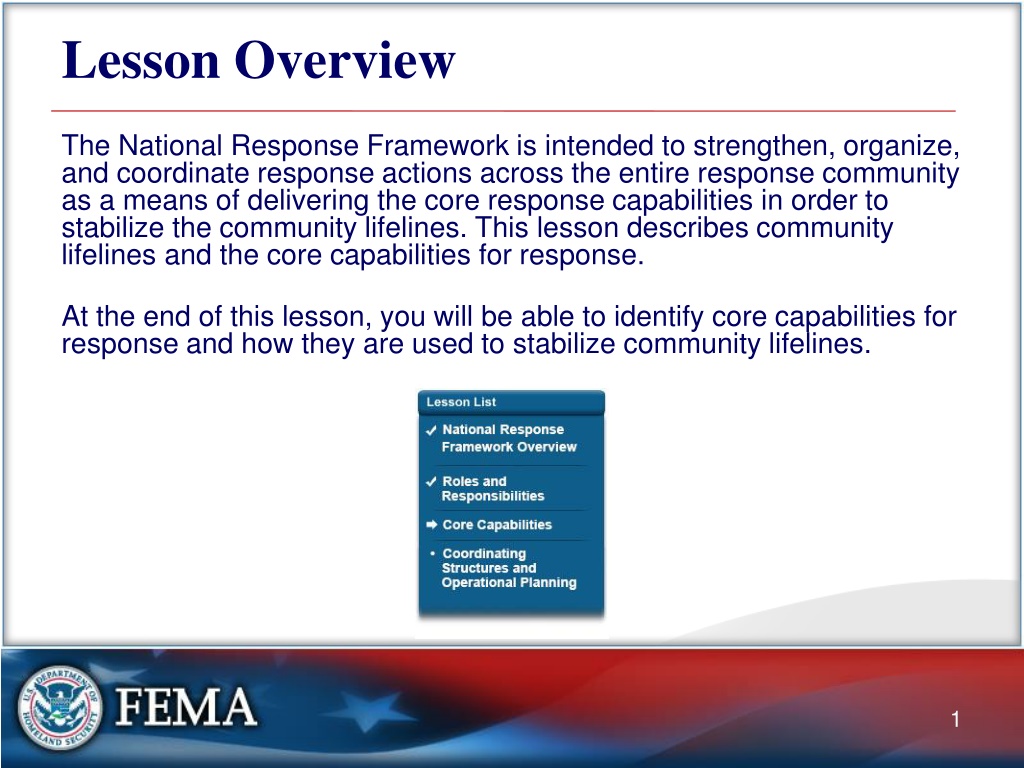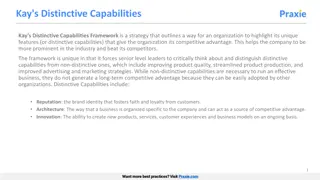Understanding Community Lifelines and Core Response Capabilities for Stabilizing Communities
The National Response Framework aims to strengthen response actions by coordinating across the entire community to stabilize community lifelines. Community lifelines are critical services essential for human health, safety, and economic security. Stabilizing these lifelines is crucial during response to mitigate threats to public health, safety, and security. The lesson discusses the seven community lifelines, their interdependence, and how they drive outcome-based response actions to stabilize communities and ensure operational coordination across various sectors.
- Community Lifelines
- Response Capabilities
- National Response Framework
- Stabilizing Communities
- Emergency Management
Download Presentation

Please find below an Image/Link to download the presentation.
The content on the website is provided AS IS for your information and personal use only. It may not be sold, licensed, or shared on other websites without obtaining consent from the author. Download presentation by click this link. If you encounter any issues during the download, it is possible that the publisher has removed the file from their server.
E N D
Presentation Transcript
Lesson Overview The National Response Framework is intended to strengthen, organize, and coordinate response actions across the entire response community as a means of delivering the core response capabilities in order to stabilize the community lifelines. This lesson describes community lifelines and the core capabilities for response. At the end of this lesson, you will be able to identify core capabilities for response and how they are used to stabilize community lifelines. 1
Community Lifelines A community lifeline enables the continuous operation of critical government and business functions and is essential to human health and safety or economic security. The seven community lifelines represent only the most basic services a community relies on and which, when stable, enable all other activity within a community. Stabilizing community lifelines is the primary effort during response to lessen threats and hazards to public health and safety, the economy, and security. 2
Community Lifelines, continued 1. Safety and Security 2. Food, Water, and Sheltering 3. Health and Medical 4. Energy (Power and Fuel) 5. Communications 6. Transportation 7. Hazardous Material Community lifelines rely on multiple government entities, business, and infrastructure sectors to function. Because the community lifelines are interdependent, failures in one will often cascade across to others. Read more about Community Lifelines (www.fema.gov/lifelines). 3
Lifelines Drive Response Incidence Response Process Application Community lifelines can be used by all levels of government, the private sector, and other partners to facilitate operational coordination and drive outcome-based response. Community lifelines are assessed and reassessed throughout an incident and help to identify required response actions each operational period until stabilization is achieved. 4
Examples: Lifelines and their impacts on other aspects of a community The community lifelines do not directly cover all important aspects of community life that can be affected by an incident but are often the root cause of impacts to other services. Example of Impacts on Financial Services After a Community Lifeline Disruption A tornado has caused massive devastation in a rural town. Among the major impacts to community lifelines is the community's inability to access money. Power outages have kept several bank branches closed and automated teller machines (ATM) inoperable, and merchants who are open despite the power outages are only able to accept cash transactions. Some merchants, ATMs, and bank branches are already open and have been energized through grid or generator power. However, communications outages prevent them from accessing systems to process an electronic transaction. Transportation issues (road closures and blockages) limit survivors' ability to travel to the limited merchants, ATM locations, and bank branches in the area, as well as responders' ability to provide assets to stabilize critical infrastructure. These cumulative effects, while incredibly disruptive to the community are caused by a confluence of impacts to specific lifelines. By using the community lifelines construct and root cause analysis, emergency managers can assess that the major limiting factors restricting community access to money are through the power, transportation, and communications lifelines. Accordingly, a local emergency manager may alleviate the situation by considering options, such as prioritized route clearance for emergency access by power and communications crews, generators for temporary power, or deployment of mobile cell towers, for establishing connectivity until other infrastructure is restored. 5
Core Capabilities Response core capabilities are the functions or activities that generally must be accomplished in incident response regardless of which levels of government are involved. Using and implementing core capabilities is what we as a nation require in order to deal with the risks we face. As we look at the Response core capabilities, you'll notice that three core capabilities span all five mission areas: Planning, Public Information and Warning, and Operational Coordination. These help to unify the mission areas and in many ways are necessary for the success of the remaining core capabilities. 6
Cross-Cutting Capabilities Three response core capabilities span across all five mission areas. Read more about each in your Student Manual. The cross-cutting core capabilities are essential to the success of the other core capabilities. They help unify the five mission areas and establish unity of effort among all those involved in the Response mission area. 7
Capability, Objectives, and Critical Tasks There are twelve additional core capabilities that are specific to Response. Read about each in your Student Manual. 8
Knowledge Review 1 All 7 of the Community Lifelines represent the most basic services. In groups, describe the types of services represented by each lifeline. 1. Safety and Security 2. Food, Water, and Sheltering 3. Health and Medical 4. Energy (Power and Fuel) 5. Communications 6. Transportation 7. Hazardous Materials Be prepared to discuss your answer. 9
Integration: Response Core Capabilities and Mission Areas The core capabilities depend on each other to succeed. Let's review some examples to explain how: Organizations involved in providing Mass-Care Services often rely on resources and functions from organizations that provide Critical Transportation or Logistics and Supply Chain Management for commodities distribution. Public Information and Warning provides for messaging, translators, and interpreters, as well as Operational Communications for reporting and communication that allows shelters to stay in touch with operations centers. Also, there are points where the response mission area crosses with other mission areas including: Prevention Protection Mitigation Recovery To learn more, read about the National Planning Frameworks at www.fema.gov/national-planning-frameworks. 10
Relationship to the Core Capabilities So, how do Core Capabilities relate to community lifelines? Think of it this way: Lifelines = Ends (the results that Responders are trying to accomplish) Core Capabilities = Ways (methods that the Responders will use to achieve the ends) To state it another way, Responders deliver the Response Core Capabilities in order to stabilize the community lifelines. Unit 4 will discuss Emergency Support Functions (ESFs) and other constructs as the Means (source of resources) to deliver the core capabilities. The chart below shows the relationship of each Lifeline, on the left, to the Core Capabilities, shown along the bottom. 11
Knowledge Review 2 When is stabilizing community lifelines the primary effort? 12
Knowledge Review 3 Based on what we learned, let's discuss which Core Capability makes it possible to manage the life cycle of a potential crisis, determine capability requirements, and help stakeholders learn their roles? Be prepared to discuss your answer. 13
Lesson 3 Summary In this lesson, you ve learned about how the National Response Framework strengthens, organizes, and coordinates response actions across the entire response community as a means of delivering the core response capabilities to stabilize community lifelines. The next lesson presents coordinating structures used in nationwide response. 14























